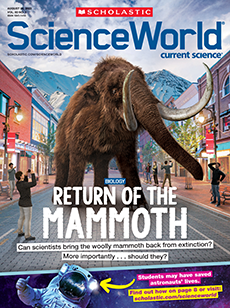What might a storm look like on an alien planet? Could a spacecraft harness the power of a newly forming star to travel faster than the speed of light? When writers behind the iconic science-fiction franchise Star Trek have out-of-this-world questions like these, they ask their trusted science adviser: astrophysicist Erin Macdonald.
Sci-Fi Adviser
Erin Macdonald uses her expertise as an astrophysicist to help bring real-world science to the fictional Star Trek universe
COURTESY OF ERIN MCDONALD (MACDONALD); CBS TELEVISION STUDIOS/ALBUM/ALAMY STOCK PHOTO (Star Trek: Strange New Worlds)
(background) ALIEN WORLD: The USS Enterprise visits a fictional planet in the TV series Star Trek: Strange New Worlds.
ILLUSTRATION BY KATY DOCKRILL
The original Star Trek series debuted in 1966. It follows the human and alien crew members of the starship USS Enterprise as they explore space in the 23rd century. The show introduced futuristic technology like transporters, which can teleport the ship’s crew to fictional planets. Since then, more than two dozen Star Trek TV series and movies have been made. “It’s been around for so long that it’s become part of our society,” says Macdonald.
Macdonald got hooked on Star Trek in college. After earning her Ph.D. in astrophysics, she moved to Los Angeles, California, and gave talks about her career and the physics of Star Trek. Hollywood producers took notice and, in 2019, hired her to advise the show Star Trek: Discovery. She is currently consulting for Star Trek: Strange New Worlds and the animated series Star Trek: Prodigy. Macdonald spoke with Science World about how she uses real science to help shape the imaginary universe of Star Trek.
CBS TELEVISION STUDIOS/ALBUM/ALAMY STOCK PHOTO
FUTURE TECH: Enterprise crew can be beamed from the ship to a planet’s surface via transporter.
Why does a science-fiction franchise like Star Trek need a science adviser?
Star Trek is fictional, but it takes place in our universe with our laws of physics. It’s just set far in the future, when we can assume technology will have greatly advanced. Star Trek has a legacy of inspiring people to become scientists and engineers. It’s important to depict science accurately in the shows.
Describe your involvement in the making of a Star Trek show.
ILLUSTRATION BY KATY DOCKRILL
When a show’s production starts, its writers brainstorm ideas and ask my advice about different scenarios. They might say, “We want there to be an accident where a character is stranded on an alien planet. What could cause it? How would the crew rescue them?” I’ll contribute ideas based on actual accidents that have occurred during space missions and scientists and engineers’ approach to problem-solving.
Once the scripts are written, I make sure any scientific dialogue makes sense based on the laws of physics. With fictional technology, like transporters, I make sure that the way we talk about them and how they work is consistent between series.
“Star Trek is fictional, but it takes place in our universe with our laws of physics.”—Erin Macdonald
Do you ever have to compromise on scientific accuracy?
Sometimes you have to make trade-offs to tell a good story. For example, there’s an episode of Strange New Worlds where the ship gets too close to a black hole. It’s a region in space with gravity so strong, even light can’t escape it. Someone asks Spock—the Enterprise’s science officer—what’s happening, and he says they’re “getting sucked into a black hole.” Technically, that’s wrong!
It’s a common misconception that black holes, like vacuum cleaners, suck in objects. It’s more accurate to say that something falls into a black hole’s gravitational well because it is so massive, it bends the space around it. I usually try to correct this language in scripts. But in this instance, I knew the writers wanted to create a sense of urgency.
CBS TELEVISION STUDIOS/ALBUM/ALAMY STOCK PHOTO
SPACE DOC: Dr. Joseph M’Benga is the Enterprise’s onboard medical doctor.
Do you need other skills besides science expertise to be a TV show science adviser?
Definitely! Knowing how to research is also important. Sometimes the writers have a science question I can’t answer right away. But I know where to look for credible sources to find the information.
You need good communication skills too. The best practice for my job came from working at a science museum and answering questions from visitors of all backgrounds and ages. That helped me be able to explain complicated ideas to different audiences—including TV writers and viewers.
